A house is never lonely where a happy and chatty guinea pig lives! They are highly social and affectionate pets with great temperaments. Guinea pigs are also intelligent little creatures with unique personalities. Owning a guinea pig, or a cavy as they are affectionately called is a highly fulfilling experience. Their adorable appearance with luscious coats that come in a large variety of colors and patterns is another reason many people love to own guinea pigs.
Guinea Pig Colors
Guinea Pigs are blessed with a large variety of stylish coat colors and patterns. According to The American Cavy Breeders Association, there are over twenty recognized colors of cavies. While the intensity of color varies, giving different hues to their shiny coats, all different colors of guinea pigs can be categorized into three main color groups.
- Brown Series
- Black Series
- White Series
The single-toned colors that we will discuss under colors are called “self”-type of guinea pig coloring. We will have a more detailed look at the more complex patterns created by combinations of these colors later on in this article. Let us now have a look at 10 of the most common and popular coat colors that these adorably fluffy pets come in.
1. White (Dark-Eyed and Pink-Eyed)
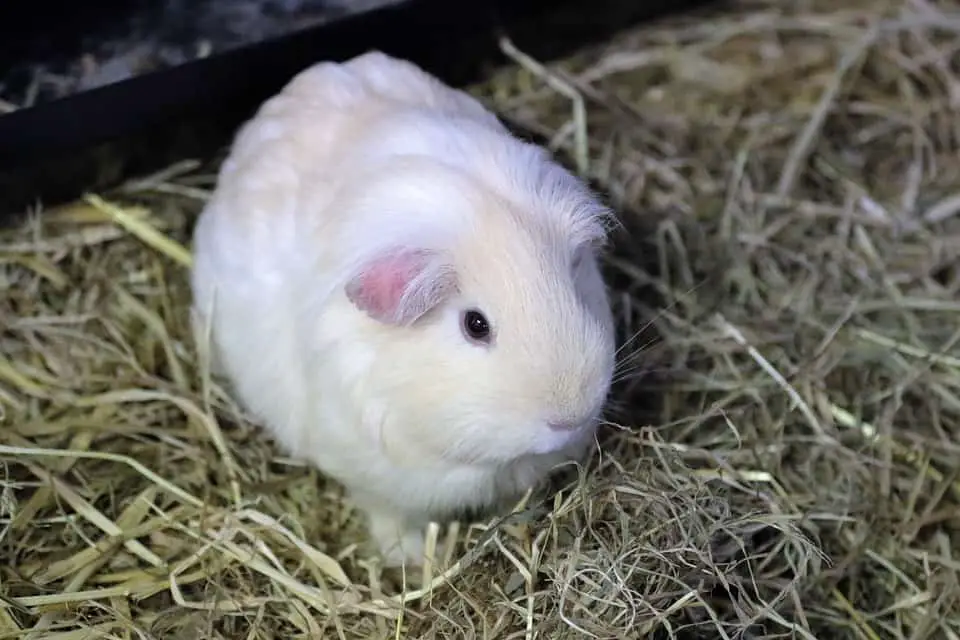
White is one of the most popular and common colors that guinea pigs come in. Since the color of a certain cavy’s coat depends on the colors/patterns of its parents, it is often easier to breed white cavies. Interestingly, however, there are two sub-varieties of pure white guinea pigs depending on the color of their eyes. This is due to a genetic mutation called albinism that affects melanin production. Whilst cavies with a mere white coat have dark eyes, albino cavies have a red or pink hue to their eyes.
2. Black
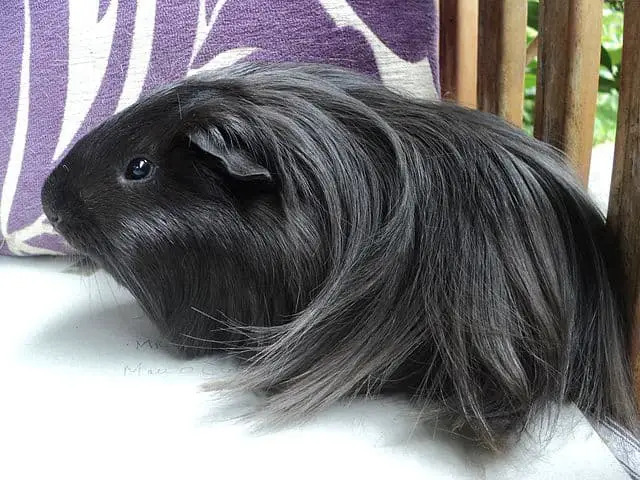
Pure black coats are also quite common among cavies and it is of course the darkest color seen on guinea pigs along with dark shades of chocolate. Pet owners often tend to prefer darker hued cavies since the maintenance of their luscious coats is relatively easier when compared to lighter colors. Black cavies with satin-textured hair are even more popular due to the sleek soft-toy-like look that it gives them.
3. Cream
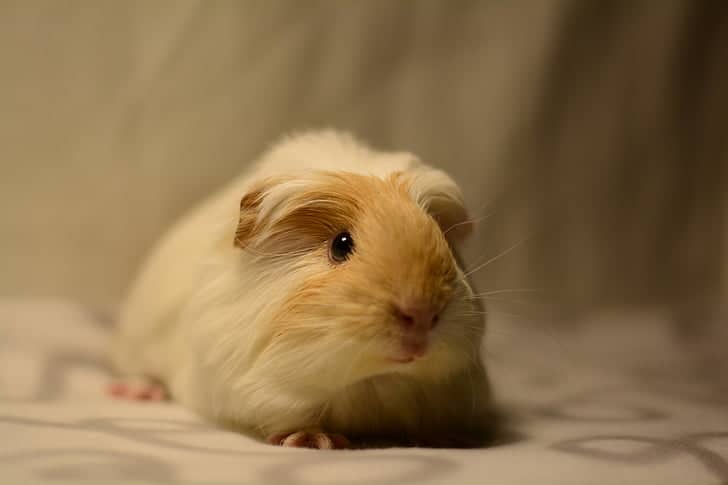
Cream-colored cavies belong to the brown series of guinea pig colors. It is a smooth off-white coat with a little more brownish pigment to it. This slight pigmentation on their coat depends on the melanin production of their skin.
4. Red
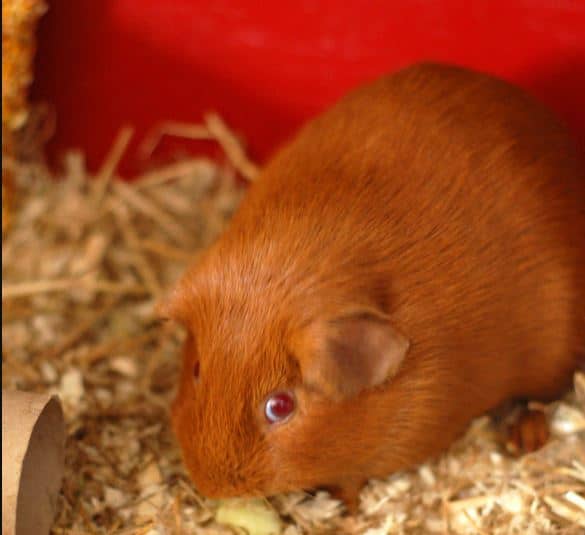
Red coats in a cavy is also a brown variety, with a darker and warmer hue to their coat. Just like in humans, red or “ginger” guinea pigs have different shares of red on their coats. It could range from a light orangish-red to a deeper sangria color.
5. Saffron/Yellow
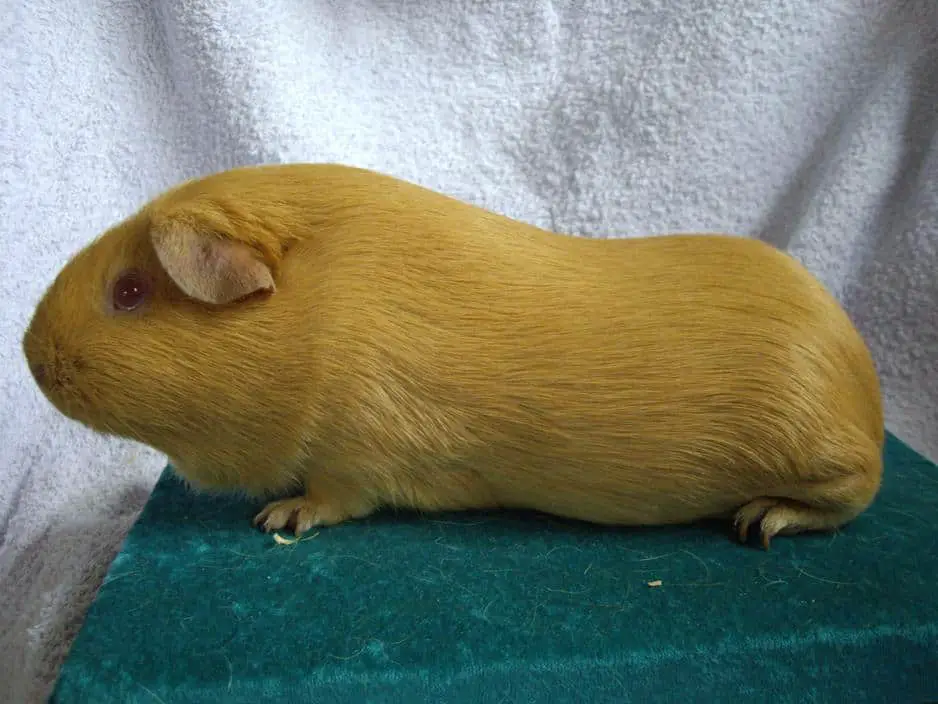
Saffron-colored cavies are a very specific and beautiful color of yellow with orange undertones. They are darker than their cream and buff-colored cousins in the brown color family, but less brownish than the red, gold, and chocolate brown cavies.
6. Chocolate
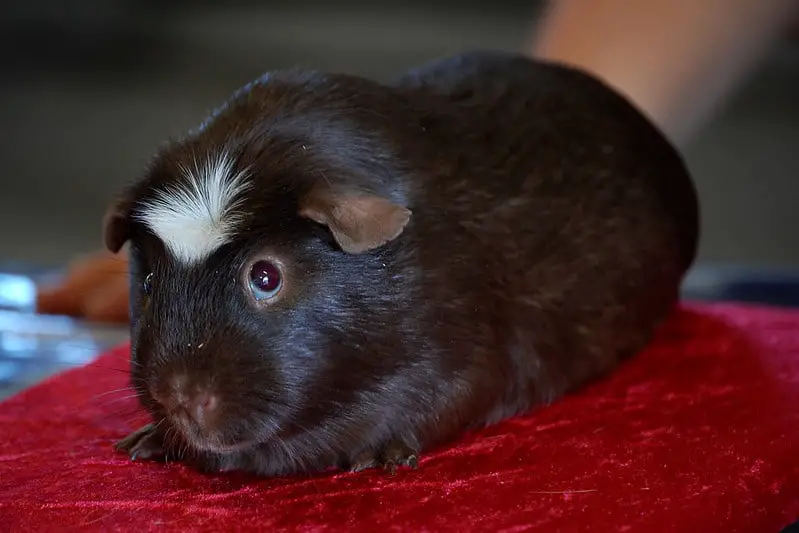
Chocolate-colored guinea pigs belong to the black color series. They have a luscious chocolate brown/black colored coat that is vividly pigmented. With their black eyes and smooth coats, chocolate cavies are a popular pet choice.
7. Slate
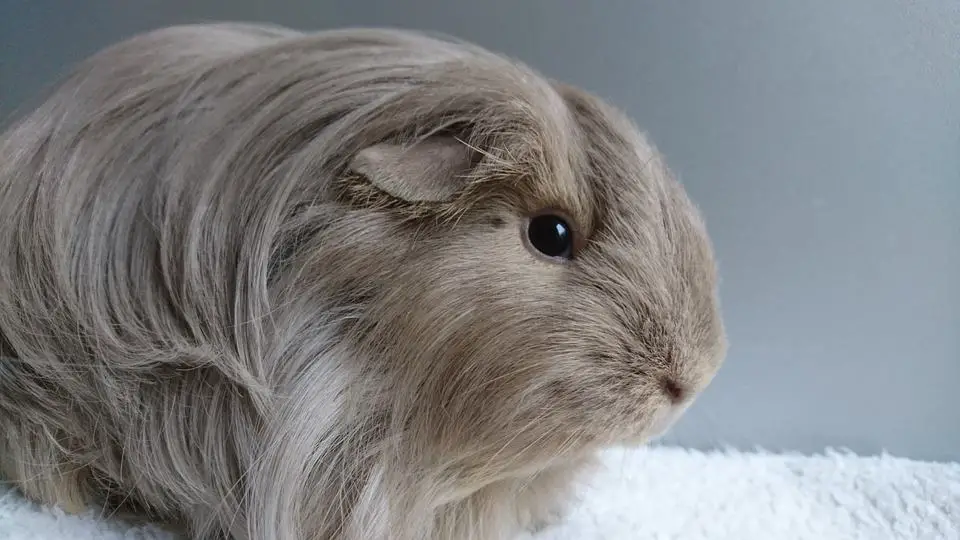
With quite a fancy name for the color of their coat, slate-colored cavies have a dark grey coat with beautifully earthy and blue undertones. They are named after slate rocks which are composed of volcanic ash. Slate-colored cavies also belong to the black color family.
8. Buff
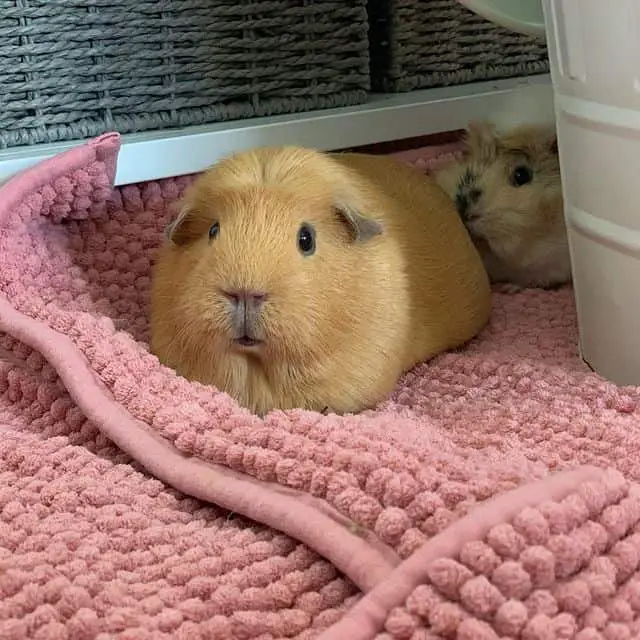
Buff-colored guinea pigs are a light yellowish-brown. Buff is short for buffalo leather and it has distinctly brown undertones. Most buff-colored cavies are born with a lighter red/brown coat, and they grow up to get a beautiful buff coat that is colored like caramel with brown undertones.
9. Gold
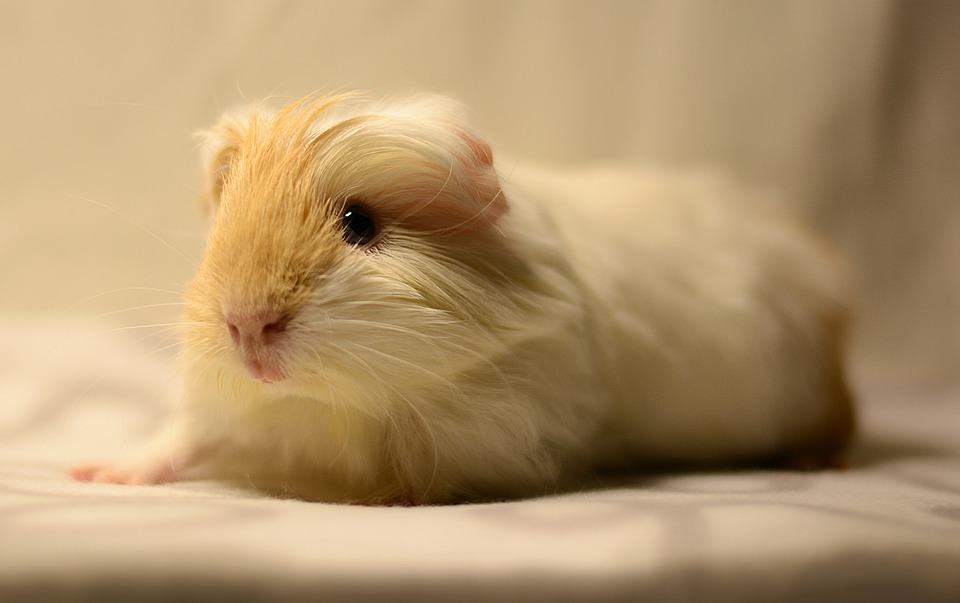
Gold cavies obviously do not have a coat that is metallic gold! It is a matte brown or dark beige shade with deep reddish gold/yellow undertones. Their coat is not too different from that of a golden retriever dog, with the gold color ranging from a pale golden shade to a deeper golden color.
10. Lilac
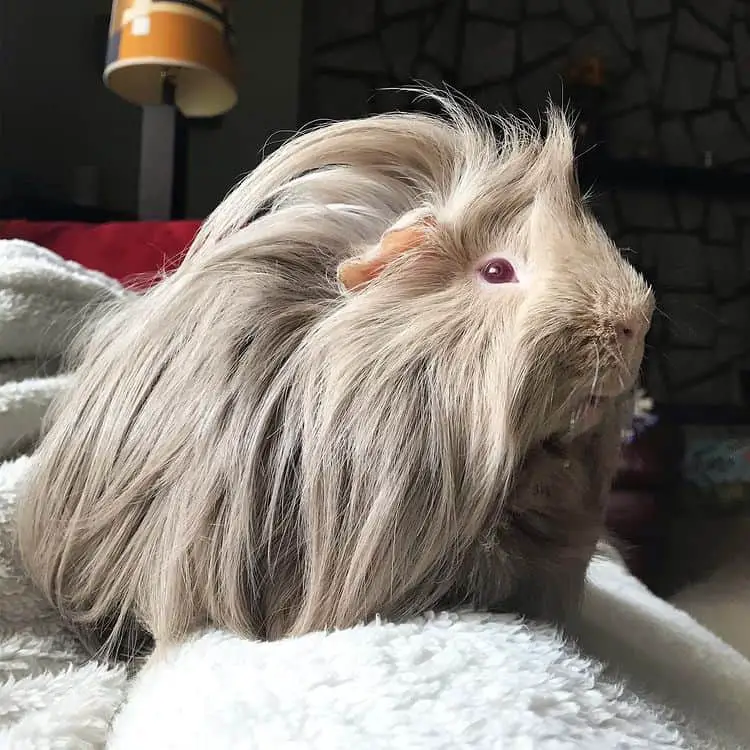
One of the most beautiful and unique coat colors that cavies come in, lilac-colored guinea pigs have a beautiful bluish-purple color mixed with white and grey. Interestingly, they belong to the black series of guinea pig colors. At first glance, lilac-hued cavies may seem gray, but with good light and proper inspection, you can see the soft lilac or violet color on their coat.
Guinea Pig Patterns
From show cavies with complex and sophisticated patterns on their coats to the ones in your pet store with the cute simple patterns, there are quite a lot of colors of patterns that guinea pigs come in. In fact, guinea pigs with patterned coats are almost always unique in their own way, with subtle variations of even the most similar patterns.
Just like the colors, the patterns of guinea pig coats can be divided into several groups.
- Self Group (white, black, red, etc.)
- Solid group (brindle, roan, golden, etc.)
- Agouti group (golden agouti, chocolate agouti, etc.)
- Marked group (dutch, dalmation, etc.)
- Tan pattern (lilac, blue, etc.)
- Agouti
1. Agouti
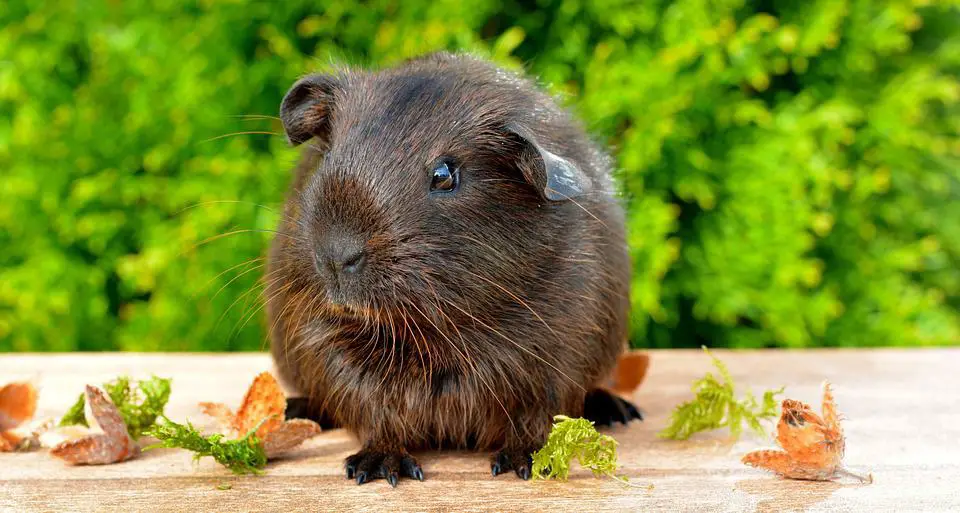
One of the most common coloring patterns found among guinea pigs, the “agouti” pattern is when the root or the “base” of the hair strand is a different color from the tip or the “ticking”. Most commonly, the base color comes from the brown/red series that we looked at above, and the tip is often various shades of colors that come from the black series.
Examples of this pattern include: Golden Agouti (Base: black, Ticking: Red) and Chocolate Agouti (Base, Chocolate, Ticking: Red)
2. Magpie
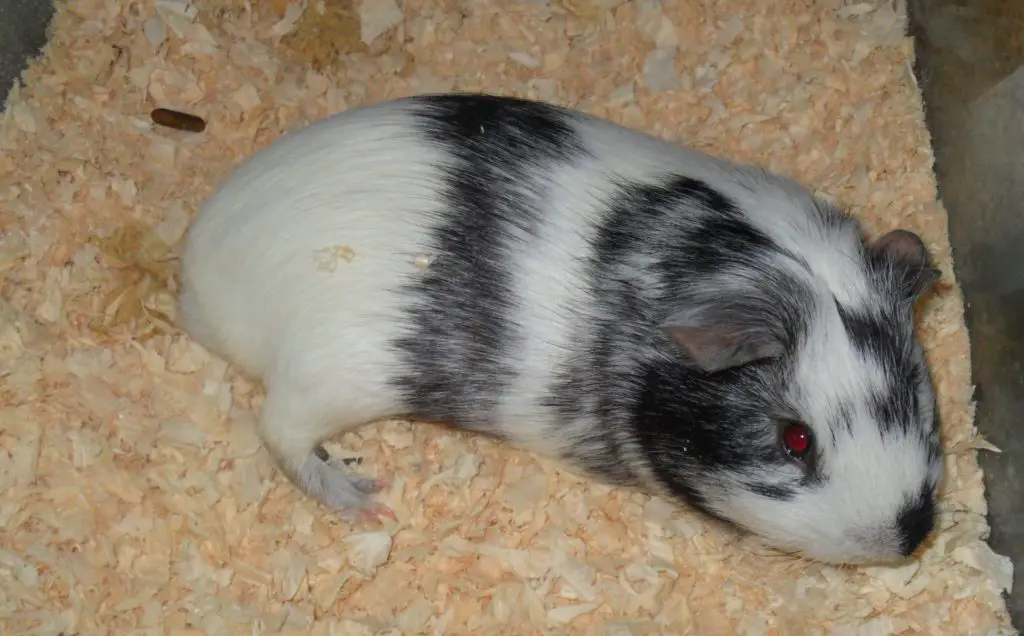
Magpie cavies are black and white, just like the namesake bird. They have wide patches of black and white dispersed all over the body, almost resembling a checkerboard.
3. Brindles
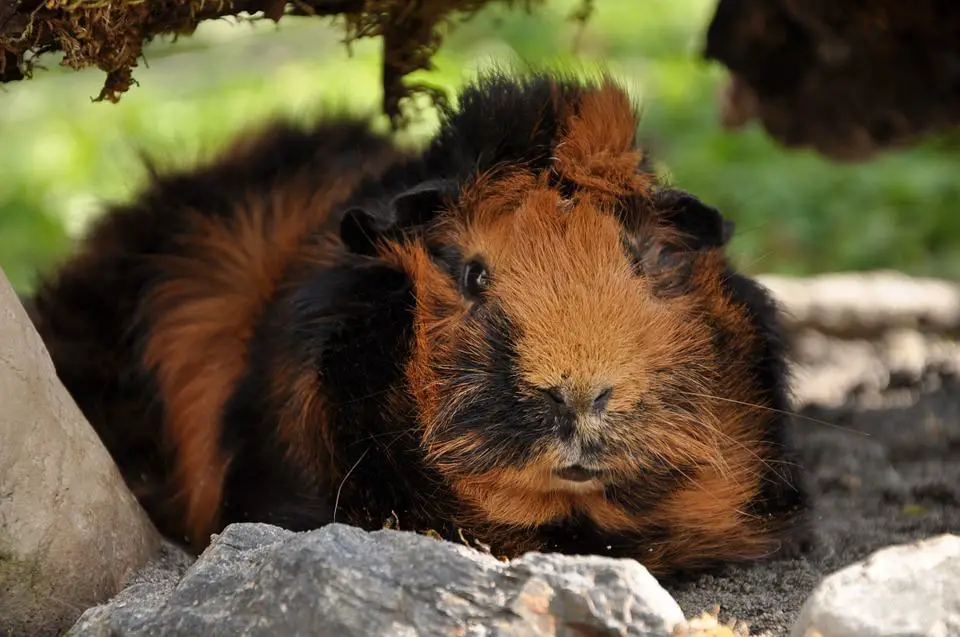
One of the rare color patterns that come on guinea pigs, Brindles have patches of red and black series colors mixed on their coat. Unlike agouti varieties, each individual hair of a Brindle’s coat is a single color. The combination of colors often varies, but the most common variety of Brindles have a honey-brown base color with black patches.
The different color patches are rather random and often they are blended or intermixed. Their fur also has a glossy tone to it. The intensity of the two colors can be different from one guinea pig to another, making them highly unique.
4. Himalayan
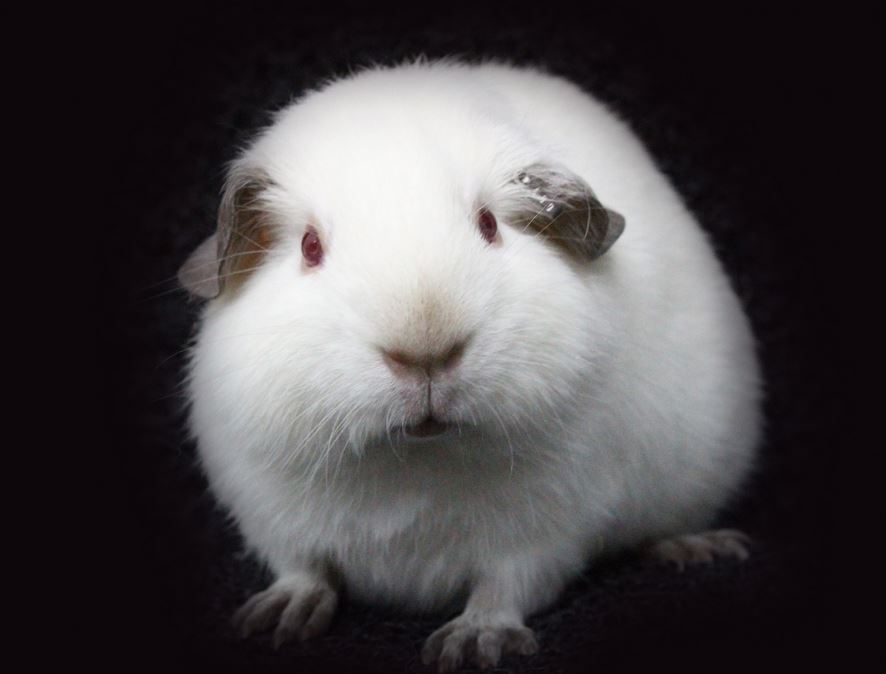
Himalayan cavies resemble the cat breed of the same name. The bulk of the fur on their coat is white or a very light shade of cream with a few patches of dark chocolate or black around their nose, ears, and feet. Himalayan guinea pigs are of an albino variety with pink eyes. The coloration of a Himalayan cavy changes according to the temperature of the environment that they live in. This makes it hard to tell the exact color and the pattern of a Himalayan’s coat as babies.
5. Argente
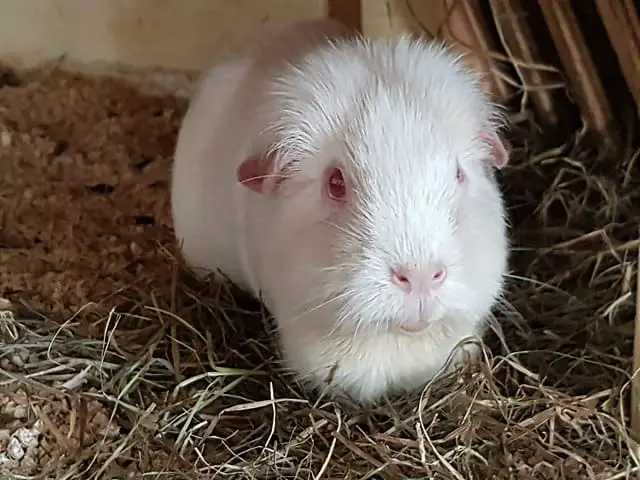
Not too different from Agouti cavies, Argente guinea pigs also come with fur that features two shades of color. However, their shading of the colors is different from an Agouti’s. They also have a unique pink hue around their eyes, which helps distinguish them from Agoutis. They are often light in color, most common shades including beige, lightly golden, and lilac.
6. Dutch
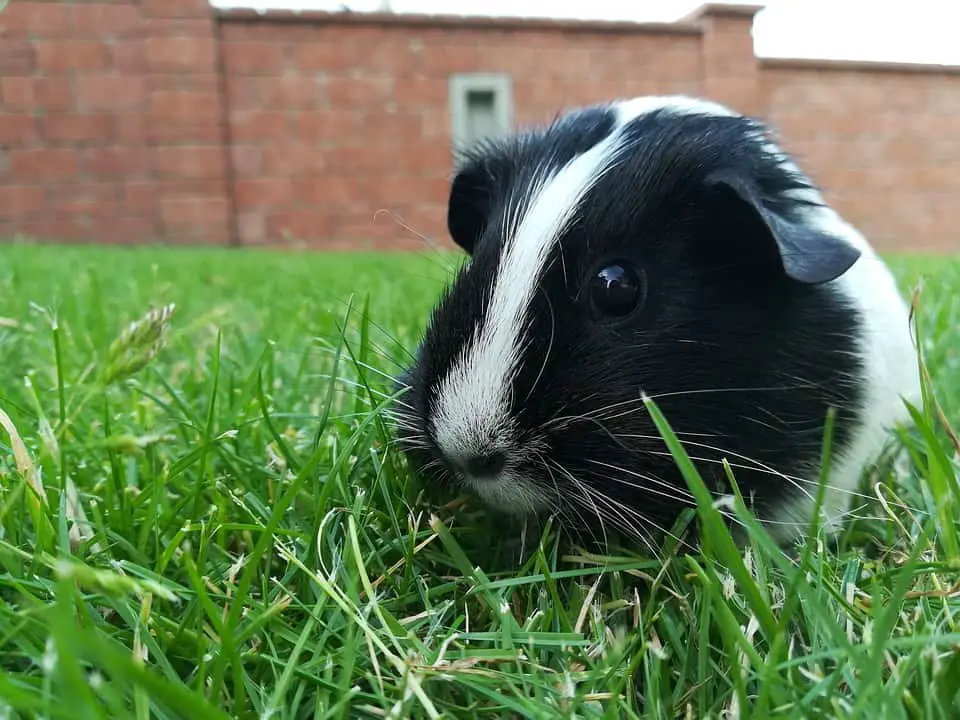
Dutch cavies are white with patches of a different color on their face and the back. The face of a Dutch cavy is often similar to their stomach and there is a triangular shape white patch around their muzzles. Their neck, chest, belly, and front paws also show distinct color markings. These Dutch markings are not perfect, which adds to their unique looks and charm.
7. Roan
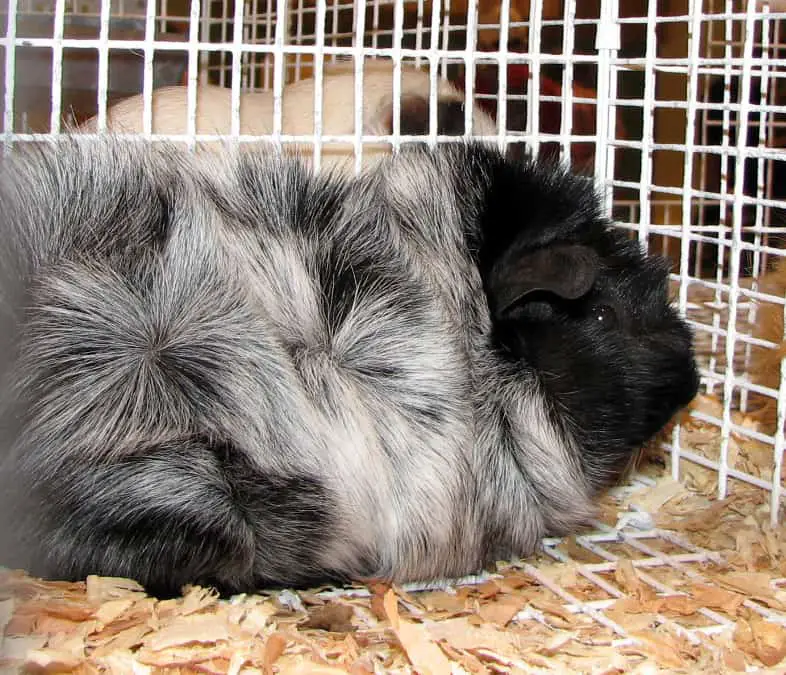
Roans have bi-colored coats, but they do not have patches of color unlike many cavies with patterned coats. Not too different from their Dalmatian cousins in the bi-color aspect, Roan cavies have a speckled coat. They have one base or dominant color, with white hairs speckled in all over the body apart from their face and feet. Due to genetic health issues, it is advised that Roan cavies should not be mated with each other since their babies have a high risk of being malformed.
8. Tortoiseshell / Tortoiseshell & White
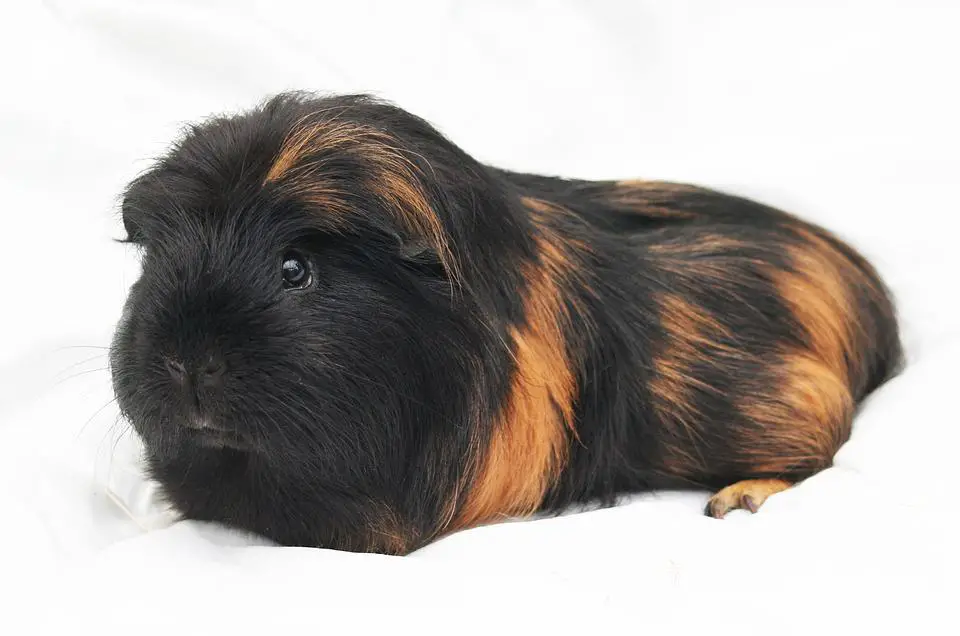
A brightly colored pattern variety, Tortoiseshell cavies have black and red coats with defined patches. There are also Tortoiseshell and White guinea pigs with another layer of pure white coloring that adds another dimension to their tortoiseshell pattern.
9. Harlequin
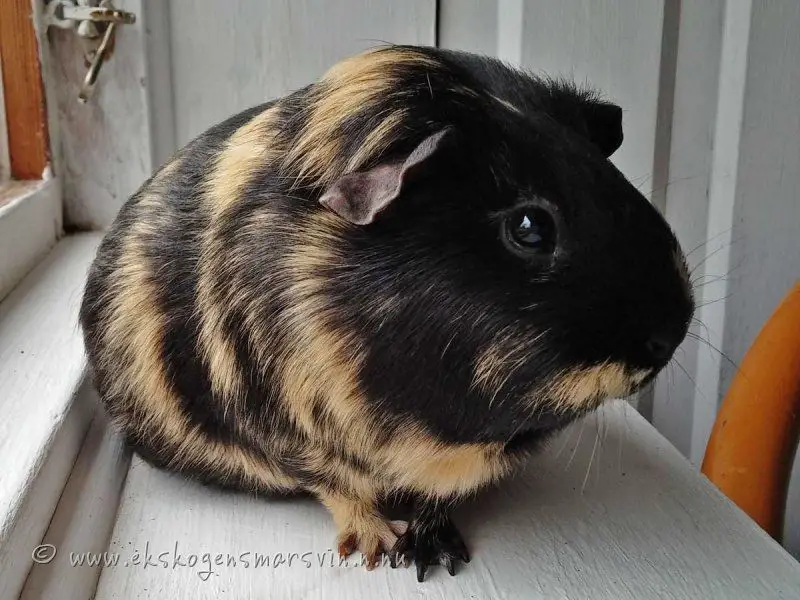
Harlequin-colored guinea pigs have a rather complex and uniquely beautiful coat. They have a light (white/cream) primary color in their coat with scattered and intermixed patches of the dark color. It is more or less similar to a half-and-half patchwork.
10. Dalmatian
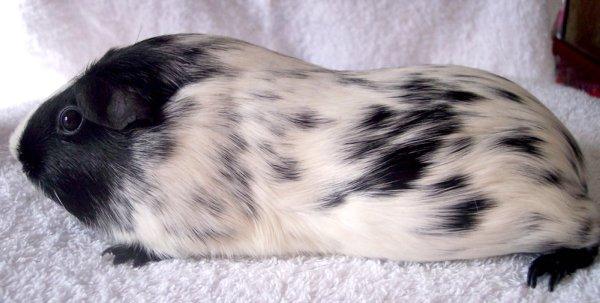
Similar to their canine namesake, dalmatian cavies have two distinct colors on their coat. One of the colors is always white and the other is a dark color from the black or brown series. Their heads have dark-colored fur with a distinct white stripe going from the top of the nose to the forehead. Some Dalmatian cavies have dark and spotless faces without the streak as well. Similar to the dog breed, they have dark patches of fur in sports all over their bodies.
However, due to genetic complications and the Dalmatian gene being problematic health-wise, it is advised that two Dalmatian guinea pigs should not be bred with each other.
11. Fox
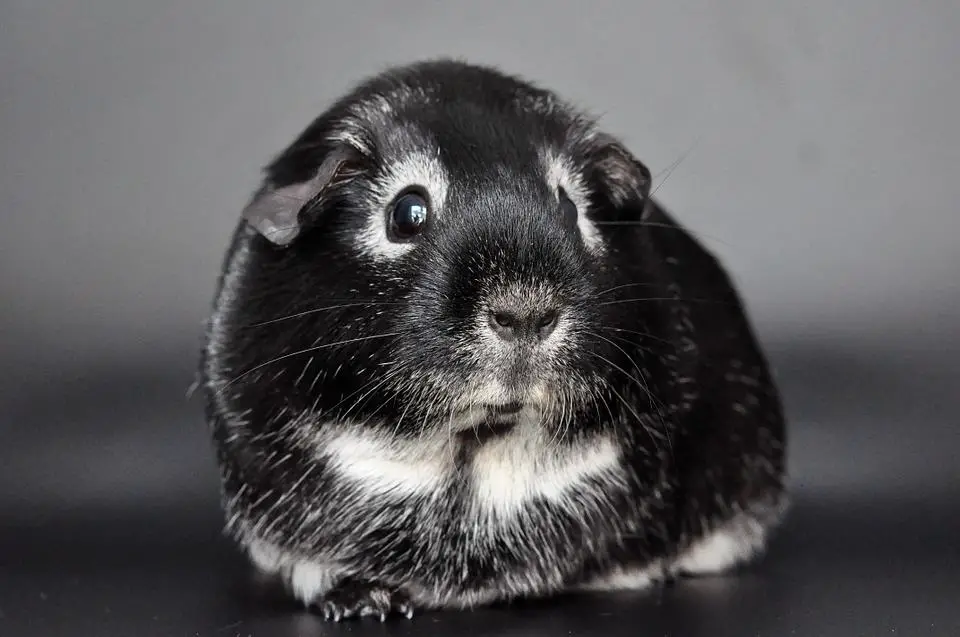
A Fox cavy is dark with pale spots around their eyes, chest, and stomach. They also have a ticking effect with different shades of fur scattered around their body. Apart from the slight pale markings, however, Fox guinea pigs have one solid color all over their body. Some of the colors that they come in are black, lilac, chocolate and beige.
Tips for Caring for a Guinea Pigs Coat
While it may be tempting to pick your new cavy according to how pretty the color and pattern of their coat are, it is important that you have a good understanding of how to care for the coat. If you do not groom the coat properly and regularly, it can be incredibly uncomfortable for your adorable new pet. Apart from a large variety of colors and pattern combinations, guinea pigs also come in several different textures and lengths of fur as well.
While you have to closely observe and understand the grooming needs of your own guinea pig, if they have short to medium-length hair, brushing one to two times a week would often suffice. Take your time and pay attention to the skin of your pet during your weekly brushings to make sure they do not have parasite infections.
If you have a longer-haired breed such as Abyssinian or Peruvian, however, you need to follow a more extensive and detailed grooming routine with brushings almost daily. Otherwise, their long hair could become matted which can be very painful for the pet.
As for bathing, you do not need to bathe them regularly since it can lead to the drying of the natural oils in their coat. However, if you see any visible fecal matter or urine, you can give a quick bath to them in the sink with a soft shampoo and lukewarm water. Other than that, using a baby wipe to regularly spot clean them will help them stay clean for longer.
Cavies are clean animals, and they naturally keep their coats and bodies quite clean. You only need to help them clean where they cannot reach, and to brush their coats so they continue to be in great condition. They, however, enjoy being groomed. Your daily or weekly grooming time with your cavy depending on the nature of their coat is a great way for you to bond with them as well. Be gentle with the brushing and make it a time to bond with them as well as examine their body for any potential signs of illness.
- How Long Do American Eskimo Dogs Live? Important Factors and Care Tips - September 29, 2023
- Do American Bulldogs Need Grooming? Essential Tips and Care Guidelines - September 29, 2023
- Do Bengal Cats Enjoy Playing? Essential Tips for Keeping Them Active - September 29, 2023